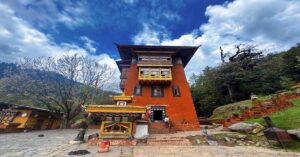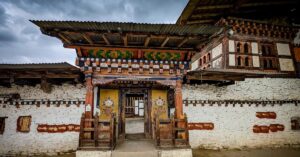Aja Ney is one of the three sacred sites of Guru Rinpoche, where he imprinted one hundred repetitions of the sacred syllable “Aa” on the cave after meditation. This holy site of Aja Ney Bhutan is located in Ngatsang village of Sherimuhung gewog under Mongar Dzongkhag in Eastern Bhutan at an altitude of 3,500m above sea level.
The mantra syllable Om Ah Hung is believed to have been hidden separately in different places. OM is in Trashiyangtse as Omba Ney, which is said to host 100 OM. AH in Mongar as Aaja Ney with 100 AH and HUNG in Mongar Sheridzong as Hungja Ney with 100 HUNG. But some people also consider Hungrel as Hung ney.
The pilgrimage trek to Aja Ney would take a week to complete.
Also Read: The Three Sacred Sites of Guru Rinpoche, which form the Buddhist Mantra, “Om Ah Hung”
How to Reach Aja Ney
Are you ready for a pilgrimage trek to Aja Nye? Be prepared to walk through the bamboo groves and meadows, and sometimes through dense forest, crossing mountains. But you would love this trek as it combines religious experiences with the trekking feel.
It can be reached from Yadi via Serzhong. Drive 18 km from Yadi to Serzhong. There are improved and widened mule tracks from Serzhong to Aja Ney. From here we have to walk for 6 hours to reach Yarab and another 5 – 6 hours to reach Aaja Ney. It is an 11 – 12-hour walk at a stretch, and most people will need to halt for a night.
The normal walking pilgrims would take 2 days to Aja Ney from Serzhong. One must hold a night at Yarab, where there is a guest house. You can pitch your tent too. Aja Ney is a day’s walk or a seven-hour walk from Yarab village. Yarab is 27 kilometers from Shermuhung Gewog center. You can also reach the sacred Ney from Lhuentse and Trashi Yangtse.
Also Read: How to Reach Omba Ney, the Taktsang of East, where Letter OM can be found
Sacred Relics to See at Aja Nye
The sacred relics found in Aja Nye are:
- A cave with one hundred inscriptions of the syllable “Aa”;
- Guru Rinpoche’s 108 retreat caves;
- Guru’s shoe and body prints;
- Khandro Dowa Zangmo’s footprints;
- Lam Karma Jamyang’s footprints;
- A mineral spring called Aja Menchu;
- Aai Chhu, a stream formed from the Guru’s walking staff.
Also Read: Guru Rinpoche in Bhutan: His Visits to Bhutan and Sacred Sites
Historical Significance of Aja Ney
According to the history of Aja Ney, the Nye was blessed by Guru Rinpoche on his way back to Tibet after defeating the Gom kora demon in Trashi Yangtse. Even though there is physical evidence of the Guru’s visit, no one knows when or why he came to the area.
According to another narrative, Aja Ney’s history dates back to 830 AD. Khikha-Rathoed (a Tibetan demon king with a dog’s mouth and a goat’s head) was exiled into an isolated deep forest. The evil Tibetan king was attempting to destroy Buddhism by establishing his dominion in Aja. Guru Rinpoche followed the trail of Khikha-Rathoed and arrived in Aja Ney. Guru Rimpoche meditated at the Ney for three months and subjugated Khikha-Rathoed. During this time, Guru Rinpoche is believed to have hidden several sacred jewels within the Ney.
Terton Ugyen Lingpa was the first to unlock the sacred site of Aja Ney in the 14th century, followed by Terton Rigzin Goeki Dhemthrug.
Guru Rinpoche prophesied that Wangchuk Dorje, the 9th Karmapa, would discover Aja Ney. However, due to his old age, his disciple Lam Karma Jamyang was directed to discover the Ney. Accordingly, Aja Ney was discovered by Lam Karma Jamyang with the help of a tiger.
Importance of Aja Ney
Why is Aja Nye important? Aja Nye is important as it is the site blessed by Guru Rinpoche where he imprinted one hundred repetitions of the sacred syllable “Aa” in the cave. The site is also important as it is associated with the subjugation of the Tibetan demon King Khikha-Rathoed by Guru Rinpoche. The site is one of the three sacred sites in Bhutan, along with Omba Ney and Hungrel Dzong, where the Buddhist Mantra Om Ah Hung is seen.
Aja Nye is important as it is the place blessed by Guru Rinpoche, and one hundred repetitions of the sacred syllable “Aa” were imprinted in the cave after meditation. It is also said that reciting one Baza Guru in Aja Ney is equivalent to chanting a thousand times in other regions.
Omba Ney in Trashi Yangtse, Aja Ney in Monggar, and Hungrel Dzong in Paro are considered equally significant sites blessed by Guru Rinpoche since their names begin with the letters Om, Ah, and Hung, which complete the Buddhist Mantra “Om Ah Hung.” Therefore, many pilgrims visit these three sites of Guru Rinpoche at least once in the order of Om Ah Hung Mantra.
Also Read: “Om Ah Hung” Ney of Guru Rinpoche in Bhutan
Description of Aja Nye
The most popular site of the Ney is a cave on the bank of Aja Chhu where Guru Rinpoche meditated for three months to subdue the Tibetan demon, King Khikha-Rathoed. Guru Rinpoche is claimed to have imprinted one hundred repetitions of the sacred syllable “Aa” on the cave’s inner walls after completing his meditation to commemorate the attainment of perfection. Thus, the name ‘Aja’ translates to the hundred syllables of “Aa.” So, Aja Ney roughly means a sacred site of a hundred inscriptions of the syllable ‘Aa.’ The pilgrims are said to experience a brief insight when they see the 100 inscriptions and are believed to be cleansed of their previous misdeeds.
Aaja Ney contains intensely blessed items such as the soil of liberation, which can be kneaded into life-extending pills, the plant of liberation, and water of liberation. In particular, the plant that grew from Guru Rimpochhe’s wind channel (Tsa Uma) looks like a noodle at the root, has a bamboo stem, and has flowers in the shape of a bell. One can be liberated from samsara just by kissing this plant. But this is very rare and only the most fortunate will be able to find it.
The Holy Ney also houses several religious landmarks and symbols, including Guru’s shoe and body prints, Khandro Dowa Zangmo’s footprints, Guru Rinpoche’s 108 retreat caves, and Lam Karma Jamyang’s footprints, among others. A pair of Jachungs can be seen at the sacred place, and the wings of the Jachungs are said to contain 108 butter lamps, 108 lakes, and 108 Tsa Tsas. There are also two golden fish.
Most pilgrims also travel a day from Aja to visit another sacred site, Neychen Phunying in Lhuentse. It is believed that the pilgrimage to Aja Ney isn’t complete without a visit to Phunying Ney.
Aja Ney Pilgrimage (Aja Ney Neykor)
There are four divisions of pilgrimage in Aaja Ney: Barkor, Nangkor, Tsekor, and Ra kor or Rongkor. Taking the Zhabjethang Lhakhang (not to be confused with Zhabjethang of Bumthang Chhoekhor Toe) as the reference, to its east is Barkor, to its north is Nangkor, to its north-east is Tsekor. All the sightseeing is done from the right and ends on the left. Altogether, it takes three days. Rakor or Rongkor can be visited while returning from Zhabjethang Lhakhang towards Yarab by taking a separate route towards the south. However, if one wishes to continue towards Phunyingla and return home via Lhuentse, one has to dedicate a separate time to visit the Rongkor.
Aja Menchu and Uma Chhu
The Aja Ney also has a mineral spring water called Aja Menchu. Menchu is believed to cure 18 diseases, including tuberculosis, body aches, ulcers, and whooping cough. People from across the country visit to soak in the Menchu and reap the benefits of its healing effects.
Also Read: Menchu or Medicinal Springs in Bhutan: Beliefs and Benefits
Aai Chhu or Awa Chhu, a stream that flows down from the rocky cliff in Tshekor, is said to have formed after the Guru’s walking stick was implanted in the rock. The stream flows into a rock basin, providing a pool where the Guru Rinpoche is said to have bathed. Bathing in a pool is said to purify a person.
The sacred Awa Chhu was renamed UMA CHHU by His Eminence Vairochana Rinpoche Ngawang Jigme Jigten Wangchuk during the visit of HE to Aja Ney in 2021. Two words depict the same meaning.
UMA CHHU is also known as Chhu Drowa Denpa, as if we take a bath or drink from it, we will be born in the upper realm and attain Nirvana.
Accommodation at Aja Ney
There are guesthouses near the monastery. You can contact Aja Ney Lam Dorji Tenzin at 17681380.
Best Time to Visit Aja Ney
Aja Ney is open in Winter, early Spring, and mid-October. Usually, the best time to visit Aaja Ney is March and April (the first two months of the lunar calendar). Pilgrimage is strictly restricted during the Ladam (Closure of Mountains) from the 15th day of the 4th lunar month till the 15th day of the 8th lunar month. It is the harvesting time for the farmers of Sherimuhung. Ladam has been a culture since time immemorial to restrict the pilgrimage as people would defile the sacred site and anger the deities, causing untimely rain and ruining the harvest. You can visit the major pilgrimage sites of Mongar with the Bhutan Pilgrimage Package.
Also Read: The Best Time to Visit Singye Dzong
Frequently Asked Questions
Where is Aja Ney located in Bhutan?
Aja Ney is located in Ngatsang village of Sherimuhung Gewog under Mongar Dzongkhag at an altitude of more than 3,500 meters.
Who discovered Aja Nye?
Lam Karma Jamyang discovered Aja Nye with the help of a tiger. Guru Rinpoche prophesied that Wangchuk Dorje, the 9th Karmapa, would discover Aja Ney. However, due to his old age, his disciple Lam Karma Jamyang was directed to discover the Ney.
Why is Aja Ney important?
Aja Nye is important as it is the site blessed by Guru Rinpoche where he imprinted one hundred repetitions of the sacred syllable “Aa” in the cave. The site is also important as it is associated with the subjugation of the Tibetan demon King Khikha-Rathoed by Guru Rinpoche. The site is one of the three sacred sites in Bhutan, along with Omba Ney and Hungrel Dzong, where the Buddhist Mantra Om Ah Hung is seen.
What do people do to preserve the Aja Nye?
The people of Aja preserve the sacredness of Aja Ney by following a centuries-old tradition of closing Aja Ney to visitors from March to October, known as Ladam. This helps limit disturbance to the sacred sites. As Aja Ney falls under the protected Bumdeling Wildlife Sanctuary, the officials also strive to preserve the sanctity and natural environment of the sacred Aja Ney site.
Enjoyed reading this blog?




